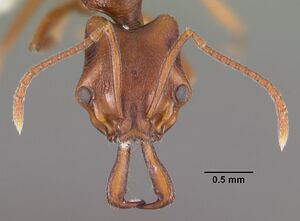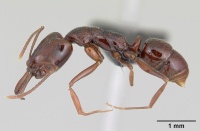Anochetus pattersoni
| Anochetus pattersoni | |
|---|---|

| |
| Scientific classification | |
| Kingdom: | Animalia |
| Phylum: | Arthropoda |
| Class: | Insecta |
| Order: | Hymenoptera |
| Family: | Formicidae |
| Subfamily: | Ponerinae |
| Tribe: | Ponerini |
| Genus: | Anochetus |
| Species: | A. pattersoni |
| Binomial name | |
| Anochetus pattersoni Fisher, 2008 | |
Males have been collected in Malaise traps.
Identification
No other species of Anochetus have been recorded from the Seychelles.
Keys including this Species
Distribution
Known only from the Aldabra Island group, Seychelles. A majority of collections have come from Isle Picard.
Latitudinal Distribution Pattern
Latitudinal Range: -9.392777778° to -9.392777778°.
| North Temperate |
North Subtropical |
Tropical | South Subtropical |
South Temperate |
- Source: AntMaps
Distribution based on Regional Taxon Lists
Malagasy Region: Madagascar, Seychelles (type locality).
Distribution based on AntMaps
Distribution based on AntWeb specimens
Check data from AntWeb
Countries Occupied
| Number of countries occupied by this species based on AntWiki Regional Taxon Lists. In general, fewer countries occupied indicates a narrower range, while more countries indicates a more widespread species. |

|
Estimated Abundance
| Relative abundance based on number of AntMaps records per species (this species within the purple bar). Fewer records (to the left) indicates a less abundant/encountered species while more records (to the right) indicates more abundant/encountered species. |

|
Biology
|
Castes
Worker
Images from AntWeb
   
| |
| Worker. Specimen code casent0172374. Photographer April Nobile, uploaded by California Academy of Sciences. | Owned by ANIC, Canberra, Australia. |
   
| |
| Worker. Specimen code casent0172375. Photographer April Nobile, uploaded by California Academy of Sciences. | Owned by ANIC, Canberra, Australia. |
   
| |
| Worker. Specimen code casent0172609. Photographer April Nobile, uploaded by California Academy of Sciences. | Owned by LACM, Los Angeles, CA, USA. |
   
| |
| Worker. Specimen code casent0172610. Photographer April Nobile, uploaded by California Academy of Sciences. | Owned by LACM, Los Angeles, CA, USA. |
 
| |
| Holotype of Anochetus pattersoni. Worker. Specimen code casent0068352. Photographer April Nobile, uploaded by California Academy of Sciences. | Owned by CAS, San Francisco, CA, USA. |
   
| |
| Worker. Specimen code casent0102280. Photographer April Nobile, uploaded by California Academy of Sciences. | Owned by NHMUK, London, UK. |
Queen
Images from AntWeb
   
| |
| Queen (alate/dealate). Specimen code casent0103343. Photographer April Nobile, uploaded by California Academy of Sciences. | Owned by CAS, San Francisco, CA, USA. |
Male
Images from AntWeb
     
| |
| Male (alate). Specimen code casent0172611. Photographer April Nobile, uploaded by California Academy of Sciences. | Owned by LACM, Los Angeles, CA, USA. |
      
| |
| Male (alate). Specimen code casent0172617. Photographer April Nobile, uploaded by California Academy of Sciences. | Owned by LACM, Los Angeles, CA, USA. |
Nomenclature
The following information is derived from Barry Bolton's Online Catalogue of the Ants of the World.
- pattersoni. Anochetus pattersoni Fisher, in Fisher & Smith, 2008: 13, figs. 7a-h, 8d (w.q.m.) SEYCHELLES.
- Type-material: holotype worker.
- Type-locality: Seychelles: Aldabra Group, Picard I., in old “Settlement”, 9°23’34’’S, 46°12’14’’E, 5 m., 19.xii.1905, SMG14998 (S.M. Goodman).
- Type-depository: CASC.
- Distribution: Seychelles (Aldabra Group).
Unless otherwise noted the text for the remainder of this section is reported from the publication that includes the original description.
Description
Worker
Measurements: maximum and minimum based on all specimens, n = 8, (holotype): HL 1.32–1.40 (1.40), HW 1.25–1.31 (1.31), CI 93–95 (94), EL 0.20–0.26 (0.23), ML 0.67–0.72 (0.72), MI 50–51 (51), SL 1.07–1.15 (1.15) SI 85–88 (88), WL 1.62–1.79 (1.78), FL 1.11–1.20 (1.19), PW 0.70–0.76 (0.74).
Dorsal margin of petiole node concave medially. Anterior portion of pronotal dorsum lightly sculptured compared to posterior portion of pronotum. Propodeal dorsum and angle transversely coarsely rugose, declivitous face below angle with transverse striae, with sculpture thinning near base of face; propodeum angulate in lateral view. Petiole scale broad; anterior half of first gastral tergum smooth and shiny with only fine punctures at base of setae. This species is most similar to the graeffei a widespread species across the Indo-Pacific, but differs from the latter by the pattern of sculpture on the mesosomal dorsum, shape the petiole (concave), broader petiole node as seen in lateral view, and its much larger size (HL+ML 1.99–2.12 mm in pattersoni, HL+ML<1.75 mm in Anochetus graeffei).
Queen
Measurements: maximum and minimum based on n = 1. HL 1.31, HW 1.29, CI 99, EL 0.30, ML 0.64, MI 49, SL 1.05, SI 81, WL 1.81, FL 1.15, PW 0.79.
Male
Measurements: maximum and minimum based on n = 2 from Madagascar: HL 0.86–0.87, HW 1.07–1.10, CI 124–126, EL 0.65–0.67, SL 0.18, SI 17, WL 1.72–1.77, FL 1.21–1.26
Type Material
Holotype: worker, Seychelles Aldabra Group, Picard Island, in old “Settlement” 09°23′34"S 046°12′14"E 5 m, mostly Casuarina with coco palms, exotic vegetation, found after dark on concrete slab in abandoned settlement 19-Dec-05 (coll. S.M.Goodman) collection code: SMG14998 CASENT0068352 1w (California Academy of Sciences).
References
- Fisher, B. L. and M. A. Smith. 2008. A Revision of Malagasy Species of Anochetus Mayr and Odontomachus Latreille (Hymenoptera: Formicidae). PloS one. 3:e1787.
References based on Global Ant Biodiversity Informatics
- Fisher B. L., and M. A. Smith. 2008. A revision of Malagasy species of Anochetus Mayr and Odontomachus Latreille (Hymenoptera: Formicidae). PLoS ONE 3(5): e1787. doi:10.1371/journal.pone.0001787

